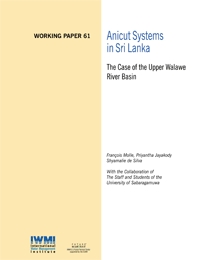Anicut systems in Sri Lanka: The case of the Upper Walawe River Basin.
Citation:
Molle, F.; Jayakody, P.; de Silva, S. 2003. Anicut systems in Sri Lanka:Â The case of the Upper Walawe River Basin. Colombo, Sri Lanka: IWMI. iii, 24p. [IWMI working paper 61]
Abstract
This exploratory study was designed to capture the main features of agrarian change in the upper part of the basin that depends mostly on anicuts. These anicuts amount to 59 percent of the total basin anicuts in terms of numbers, but to only 43 percent in terms of irrigated area. They are generally very old (the history of some of them goes back to 2000 years; see below) and obviously, many changes have occurred during this time. The study does not allow the reconstitution of all past transformations but offers some insight on recent changes: changes in population pressure over resources and changes in hydrology, crop choice, livelihoods and collective action. The analysis is based on exploratory surveys carried out by the authors and by students of the University of Sabaragamuwa and is not a detailed or in-depth investigation of agricultural systems in the Upper Walawe basin. However, it provides a useful outline of the situation in this part of the basin.


